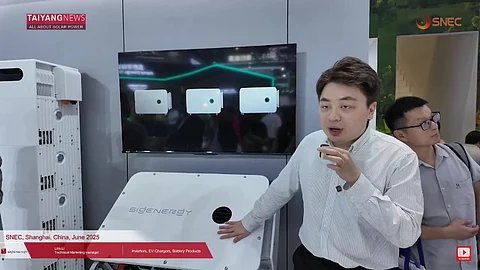

Sigenergy showcased its residential-scale SigenStor ESS, consisting of an energy controller, bidirectional EV DC charger, and a vertically stacked battery bank
The displayed SigenMicro Inverter series is compatible with the WiFi mesh technology communication protocol
For C&I prosumers, the company promoted its 3-phase on-grid Sigen PV inverter and a Sigen hybrid inverter at the event
Sigenergy showcased its latest product lineup at SNEC 2025 in Shanghai, China. The lineup included the company’s latest hybrid inverters, energy storage solutions (ESS), microinverters, and digital solutions for both residential and commercial and industrial (C&I) consumers.
Link Li, Technical Marketing Manager at Sigenergy, gave the TaiyangNews team a walk-through of the displayed products during a short interview.
The single-phase SigenStor ESS model on display features a stackable and modular architecture. According to the datasheet, it integrates the SigenStor energy controller module at the top, connected with an underlying bidirectional electric vehicle (EV) charger and SigenStor BAT series battery modules. The energy controller, designed to accommodate 4 MPPT channels, each capable of connecting one 1,000 V DC PV string, can handle a PV array of up to 24 kW. Each MPPT is rated for a maximum input current of 16 A. According to the datasheet, the product is engineered to endure 200% DC/AC oversizing and can deliver single-phase power of up to 12 kW and an output current of up to 54.6 A.
The Sigen EV DC charging module can offer up to 25 kW bidirectional charging of the prosumer’s connected EV. In addition, the system allows for V2G charging, where the connected vehicle can directly discharge its in-built battery bank’s stored energy to the grid.
This EV charging module is subsequently connected to the battery module stack. Consisting of 280 Ah capacity LiFePO4 battery cells, each SigenStor battery module can store up to 8.06 kWh of energy. According to the datasheet, the maximum limit of charge and discharge power is 4,000 W. In terms of scalability, this system supports a maximum of 6 stackable battery modules.
On the Module-Level Power Electronics (MLPE) variant, Li introduced the displayed SigenMicro Inverter series. Crafted with an MPPT channel of 16 V to 60 V voltage range, connecting 2 PV modules, this product can deliver up to 1,000 W single-phase AC. Li emphasized that this solution is compatible with WiFi mesh technology. It enables a connected PV array’s self-power optimization in 150 ms.
Li also briefly described the company’s smart home system. It supports shelly switches, a smart switch that can integrate smart devices with solar generation cycles and power appliances during peak sunlight hours by smart scheduling. It also enables the connected energy controller to choose between solar surplus or battery power, according to the spec sheet.
For C&I prosumers, Li highlighted the company’s 3-phase Sigen PV Inverter (on-grid) and Sigen Hybrid Inverter.
The former model, featuring 8 MPPT channels, each connecting with 2 PV strings, can integrate up to 125 kW of PV array capacity. Each MPPT channel, designed to carry up to 40 A DC, has a 160 V to 1,000 V voltage range. Rated for a maximum system efficiency of 98.6%, it can cater to up to 137.5 kW C&I 3-phase load.
In contrast, the latter, engineered for compatibility with the DC-coupled ESS configurations, offers similar PV input specifications and can be paired with the SigenStack BAT 12.0 battery module. This system can deliver up to 137.5 kW AC 3-phase output power. Equipped with 314 Ah capacity cells, each battery module of SigenStack BAT 12.0 is rated at 12.06 kWh of energy. The datasheet says that each system can accommodate up to 7 modules, which takes the maximum storage capacity to 84.42 kWh. Li added that the storage capacity can be scaled up to 253 kWh by connecting 3 identical systems in parallel. The maximum charging and discharging power of the connected battery bank is rated at 137.5 kW DC.
Following an overview of the products, Li briefly demonstrated the battery stack model’s fire suppression safety feature.
